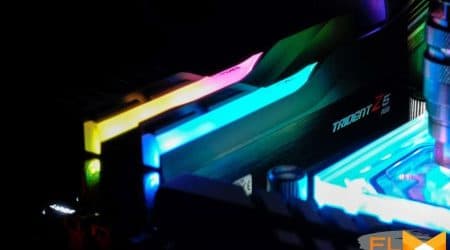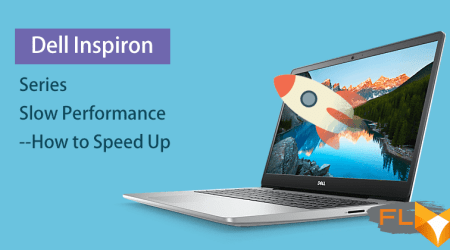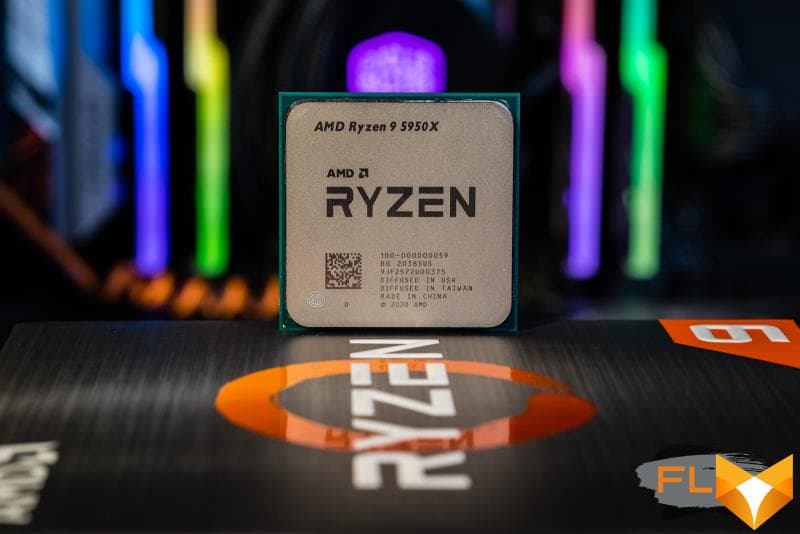


Typically, our processor tests are devoted to analyzing processor performance in the environment familiar to most users – in games and common applications for amateur content work. However, the competitive environment in the processor market has led to the fact that over the past few years, older models of mass processors have noticeably increased their performance, and now they can be used to solve much more serious tasks. First of all, AMD has succeeded in this regard. Introduced with the introduction of the Zen 2 microarchitecture, the Ryzen 9 series of processors combined those multi-core processors that can compete in terms of processing power with CPUs, most recently considered specialized professional solutions for high-end desktop computers (HEDT – High-End Desktop).
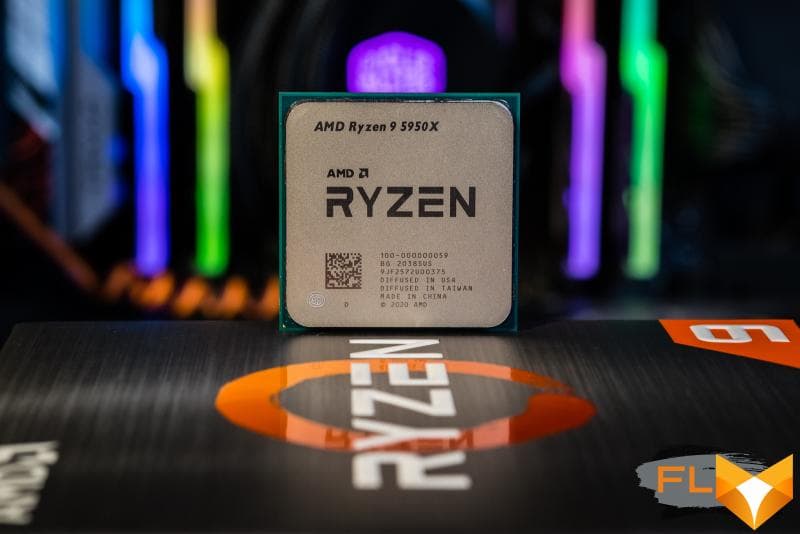
With the release of the Ryzen 9 5900X and Ryzen 9 5950X processors, AMD has actually monopolized the market for low-cost workstations: there are no solutions similar in terms of price and performance in Intel’s arsenal and are not expected in the near future. At the same time, these processors are sold much cheaper than AMD’s own specialized offerings for high-performance desktops – representatives of the Threadripper family, which, moreover, have not yet moved to the Zen 3 microarchitecture.
All this in total leads to the idea that it would not hurt to test the modern representatives of the Ryzen 9 series once again in detail, but approaching them not as mass-produced CPUs, but as HEDT-class solutions that are focused on use as part of computers for professional tasks. This is exactly what we decided to do in this article – in it we will try to answer the question of whether the older Ryzen 9 is really more attractive than the most expensive Intel Core-X desktop processors and the most affordable AMD Threadripper series processors and in which cases Ryzen 9 is really applicable in workstations .
⇡#Again about Ryzen 9 5900X and Ryzen 9 5950X
There is no need to talk in detail about the Ryzen 9 5900X and Ryzen 9 5950X processors. On our site there is a special review of these CPUs, in which we discuss in detail their architecture, structure, features and characteristics. Therefore, we recall only the basic things regarding the Ryzen 9 series in its modern form.
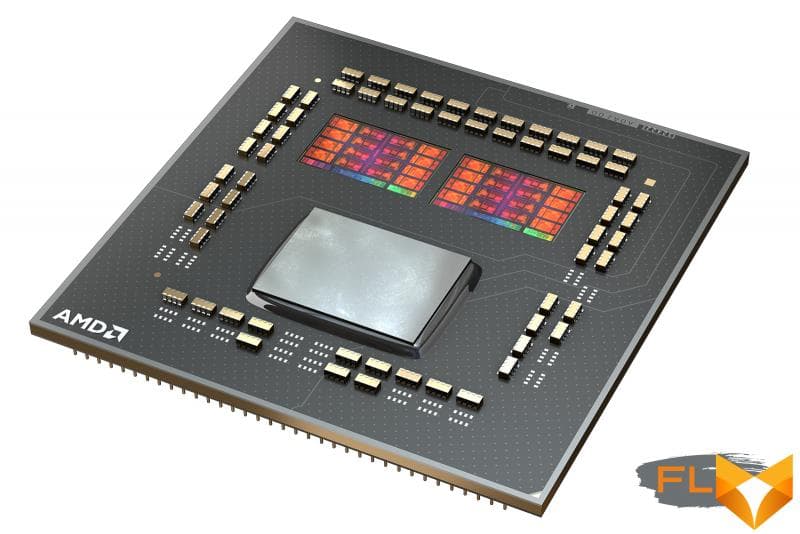
Both processors in question are not quite ordinary CPUs in the Socket AM4 ecosystem. Their main feature is that they are assembled not from two, but from three semiconductor crystals: one standard 12nm I / O chiplet and a pair of 7nm CCD chipsets with processor cores. All these crystals are combined into one whole via the Infinity Fabric bus, and in this sense, the Ryzen 9 5900X and Ryzen 9 5950X can be called the younger brothers of Threadripper or EPYC. The layout principles are similar here and there, just in the case of Ryzen 9, this scheme works on a slightly smaller scale.
It is this scheme that makes the Ryzen 9 5900X and Ryzen 9 5950X a kind of HEDT class processors in miniature. Due to two chiplets with computing cores, they can offer their owners an increased number of computing cores – 12 or 16. True, with certain reservations, which are related to the fact that we are talking about processors not for a specialized, but for the usual mass platform Socket AM4.
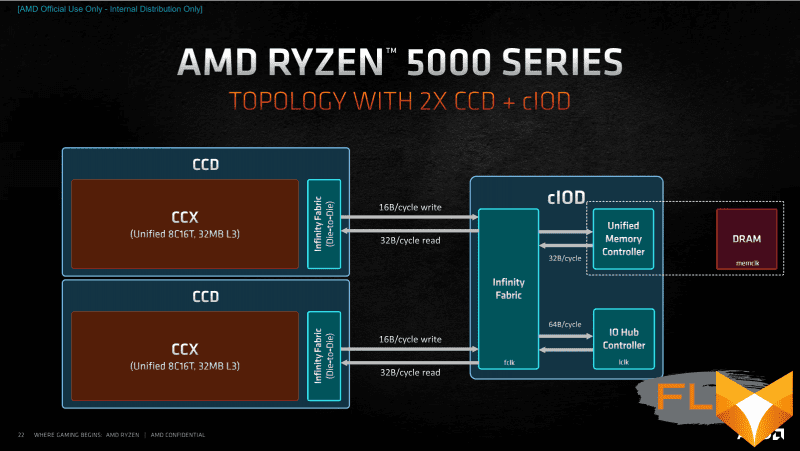
There are two sensitive restrictions. First, like the younger Ryzen, 12- and 16-core processors only have a dual-channel memory controller, and not a quad-channel or eight-channel one, like Threadripper or Threadripper PRO. Accordingly, solving some tasks that place high demands on the bandwidth of the memory subsystem on the Ryzen 9 5900X or Ryzen 9 5950X will not be the best idea. The second limitation concerns the thermal package. Socket AM4 processors are limited to 105W, while Threadripper has a TDP of 280W. And this translates into slightly lower clock speeds: for example, the 24- and 32-core Threadripper outperform the Ryzen 9 5950X in base frequency by several hundred megahertz. However, for now, this shortcoming is fully compensated by the Zen 3 microarchitecture with a high IPC.
To illustrate how the performance of the Ryzen 9 5900X and Ryzen 9 5950X look against the background of processor specifications that are considered to be true HEDT solutions, we have compiled the following table where we placed the 24-core Threadripper 3960X and the 18-core Core i9-10980XE next to the main characters.
| Ryzen 9 5900X | Ryzen 9 5950X | Core i9-10980XE | Threadripper 3960X | |
|---|---|---|---|---|
| Platform | Socket AM4 | Socket AM4 | LGA 2066 | Socket sTRX4 |
| Microarchitecture | Zen 3 | Zen 3 | Skylake | Zen 2 |
| Technical process, nm | 7/12 | 7/12 | 14 | 7/12 |
| Cores/Threads | 12/24 | 16/32 | 18/36 | 24/48 |
| Base frequency, GHz | 3,7 | 3,4 | 3.0 | 3,8 |
| Max. turbo frequency, GHz | 4,8 | 4,9 | 4,8 | 4,5 |
| L2 cache, MB | 12 × 0.5 | 16 × 0.5 | 18 × 1 | 24 × 0.5 |
| L3 cache, MB | 2 × 32 | 2 × 32 | 24.75 | 4×32 |
| Memory | 2 × DDR4-3200 | 2 × DDR4-3200 | 4 × DDR4-2933 | 4 × DDR4-3200 |
| PCIe lanes | 24 | 24 | 48 | 56 |
| TDP, W | 105 | 105 | 165 | 280 |
| Price | $549 | $799 | $979 | $1,399 |
The passport specifications of the Ryzen 9 5900X and Ryzen 9 5950X look pretty impressive, but it seems that they still fall short of the level of processors like the Core i9-10980XE and Threadripper 3960X due to the shortage in the number of processor cores. However, there is a counterargument to this argument: the processors we are considering are based on the more advanced Zen 3 microarchitecture. As our recent study showed, in terms of IPC (specific performance) in applications, it outperforms Zen 2 by an average of 11%, and Skylake by about 22 %. In addition, thanks to the transition to eight-core CCX processors with the Zen 3 microarchitecture, they are not as obviously dependent on the performance of the memory subsystem as their predecessors. This doubled the amount of L3 cache available for each processor core, and somewhat leveled the advantages of the 4-channel DDR4 SDRAM controller implemented in HEDT class processors.
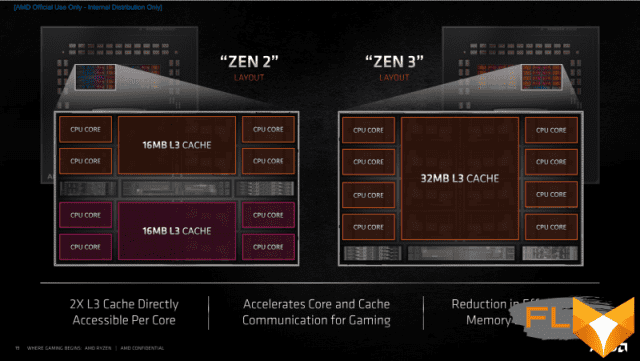
Finally, it is impossible not to highlight the price advantage. The older 16-core Ryzen 9 5950X is corny cheaper than the Threadripper 3960X (by 33%) and than the Core i9-10980XE (by 19%). In terms of cost, the Ryzen 9 5900X and Ryzen 9 5950X are more likely to be considered competitors to the older Core i9 processors for the mainstream LGA1200 platform: for example, the new eight-core Core i9-11900K is priced at $539.
⇡#Description of the test system and testing methodology
The purpose of today’s testing is to determine if the Ryzen 9 5900X and Ryzen 9 5950X processors qualify as entry-level HEDT solutions. Therefore, the main rivals in the tests for them were not too expensive processors purposefully designed for use in workstations – the 24-core Threadripper 3960X and the 18-core Core i9-10980XE. But at the same time, mass CPU models that are simpler in terms of positioning were also included in the comparison: older Core i9 models for LGA1200 with eight and ten cores, as well as the massive eight-core Ryzen 7 5800X.
Due to the fact that the tests are aimed at determining the performance of processors in professional applications, in the compared platforms, not a gaming, but a professional AMD Radeon Pro W5700 graphics card was installed, the driver of which has special optimizations for working in CAD / CAM applications.
Ultimately, the test system included the following components:
- Processors:
- AMD Ryzen Threadripper 3960X (Castle Peak, 24 cores + SMT, 3.8-4.5GHz, 128MB L3);
- AMD Ryzen 9 5950X (Vermeer, 16 cores + SMT, 3.4-4.9GHz, 64MB L3);
- AMD Ryzen 9 5900X (Vermeer, 12 cores + SMT, 3.7-4.8GHz, 64MB L3);
- AMD Ryzen 7 5800X (Vermeer, 8 cores + SMT, 3.8-4.7GHz, 32MB L3);
- Intel Core i9-10980XE (Cascade Lake-X, 18 cores + HT, 3.0-4.8GHz, 24.75MB L3);
- Intel Core i9-11900K (Rocket Lake, 8 cores + HT, 3.5-5.3GHz, 16MB L3);
- Intel Core i9-10900K (Comet Lake, 10 cores + HT, 3.7-5.3GHz, 20MB L3).
- CPU cooler: EKWB custom coolant
- Motherboards:
- ASUS ROG Strix X299-E Gaming II (LGA2066, Intel X299);
- ASUS ROG Strix TRX40-E Gaming (Socket sTR4, AMD TRX40);
- ASUS ROG Crosshair VIII Hero (Socket AM4, AMD X570);
- ASUS ROG Maximus XIII Hero (Wi-Fi) (LGA1200, Intel Z590).
- Memory: 4 × 16GB DDR4-3600 SDRAM, 16-18-18-38 (Crucial Ballistix RGB BL2K16G36C16U4BL).
- Video card: AMD Radeon Pro W5700 (Navi 10, 1630-1880/7000MHz, 8GB GDDR6 256-bit).
- Disk subsystem: Intel SSD 760p 2TB (SSDPEKKW020T8X1).
- Power supply: Thermaltake Toughpower DPS G RGB 1000W Titanium (80 Plus Titanium, 1000W).
All compared processors were tested with the settings accepted by the board manufacturers by default. This means that for Intel platforms, the power consumption limits indicated in the specifications are ignored, and instead the maximum possible frequencies are used in order to obtain maximum performance. The vast majority of users operate processors in this mode, since enabling heat dissipation and power consumption limits in most cases requires special BIOS settings.
Testing was performed on the Microsoft Windows 10 Pro (20H2) Build 19042.572 operating system using the following driver set:
- AMD Chipset Driver 2.13.27.501;
- Intel Chipset Driver 10.1.31.2;
- Radeon Pro Software for Enterprise 21.Q1.1.
For testing this time we used an atypical set of tasks. Since we are talking about the performance of processors in workstations, performance was measured using applications and benchmarks that are appropriate for their intended purpose, which are industry standard and are actively used in a professional environment:
- Adobe After Effects 2020 17.7.0 with PugetBench for After Effects 0.93.2 test suite;
- Adobe Photoshop 2021 22.2.0 with PugetBench for Photoshop 0.93 test suite;
- Adobe Premiere Pro 2020 14.9.0 with PugetBench for Premiere Pro 0.95.1 test suite;
- Autodesk AutoCAD 2021 R.47.0.0 with Cadalyst Systems Benchmark 2015 v5.5b;
- Blackmagic Design DaVinci Resolve Studio 17.1.1 with PugetBench for DaVinci Resolve 0.92.2 test suite;
- Dassault Systemes Solidworks 2021 SP3.0 with SPECapc for Solidworks 2021 test suite;
- Microsoft Visual Studio 2019 with Chromium project source code 91.0.4470.0 to measure compilation speed;
- SPECworkstation 3.1 is a test suite for determining the performance of workstations in scientific, medical, energy and engineering applications.
⇡#Performance in Adobe Photoshop
Adobe Photoshop is not one of the applications where the number of processor cores is of great importance. For this graphics editor, single-threaded performance is much more important. The same operations that can be effectively parallelized in Photoshop tend to be transferred to the GPU. Therefore, in the end, processors like the Ryzen 9 5900X and Ryzen 9 5950X perform very well here – they give the best integrated result compared to all the selected rivals.
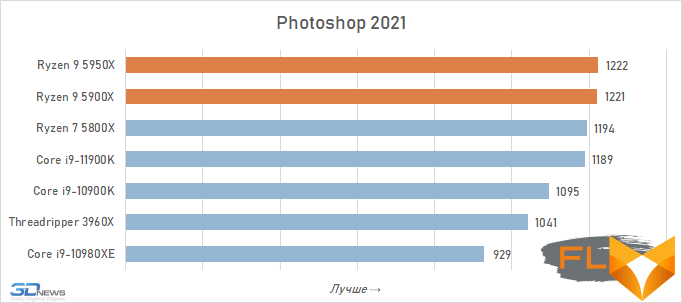
However, in most cases, even the eight-core Ryzen 7 5800X, which, like the Ryzen 9 5900X or Ryzen 9 5950X, is based on the same high-performance Zen 3 microarchitecture with a high IPC, is quite sufficient performance for a Photoshop-oriented workstation. Multi-core processors can manifest themselves only when working with some filters, which, on the one hand, are optimized for multithreading, and on the other hand, do not know how to use GPU resources properly. Examples of operations for which it really makes sense to use 12- and 16-core CPUs are content-aware fill, noise reduction, or smart sharpening.
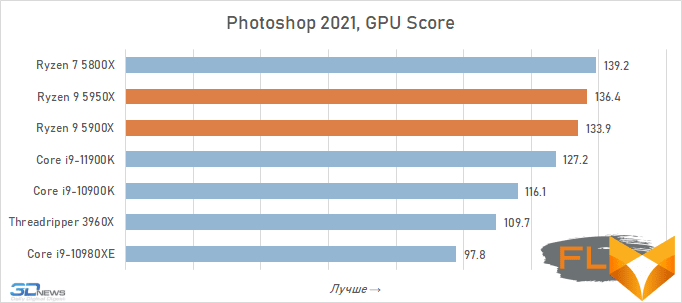
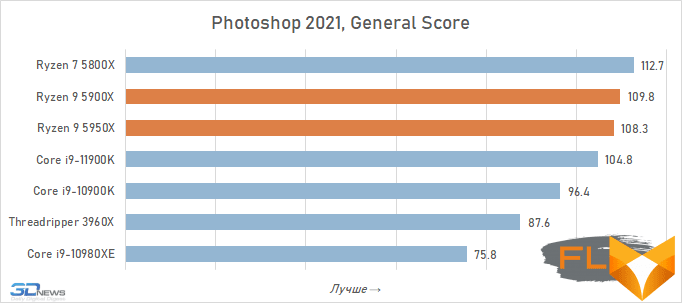
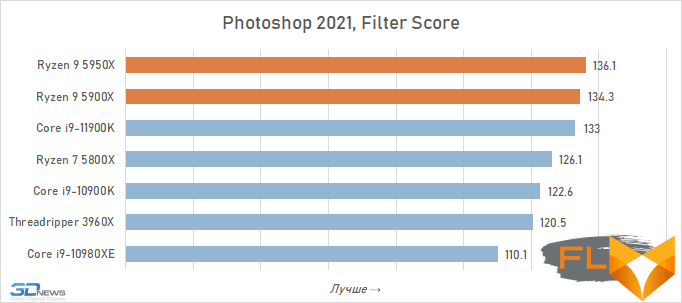
⇡#Performance in Adobe Premiere Pro
In Adobe’s popular non-linear video editing application, the importance of a large number of cores cannot be overestimated. Many operations in Premiere Pro use multithreading to the maximum, so the Ryzen 9 5950X and Ryzen 9 5900X processors lose out to the 24-core member of the Threadripper family. However, at the same time, older Ryzen 9s easily outperform both the 18-core Core i9-10980XE and all other CPUs with fewer cores. So, in the end, a workstation based on the Ryzen 9 5950X or Ryzen 9 5900X is a worthy choice for working in Premiere Pro.
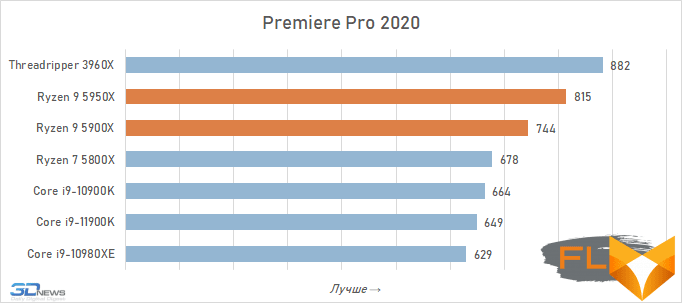
Going deeper, you’ll notice that multi-core in Premiere Pro is important at almost any stage of working with video content. But at the same time, the Threadripper 3960X bypasses the Ryzen 9 5950X by no means always, but only in two types of workload – when exporting finished projects, as well as when actively working with the timeline. Effects, on the other hand, often do not need maximum multithreading, and often are completely transferred to the video card.
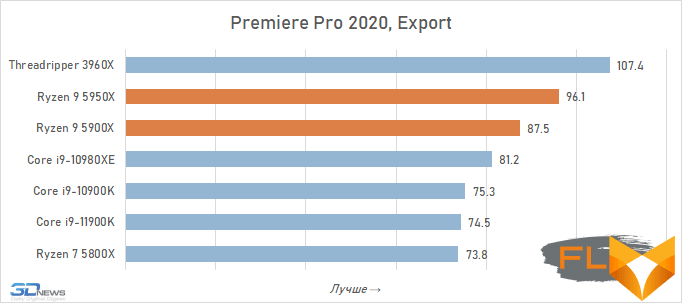
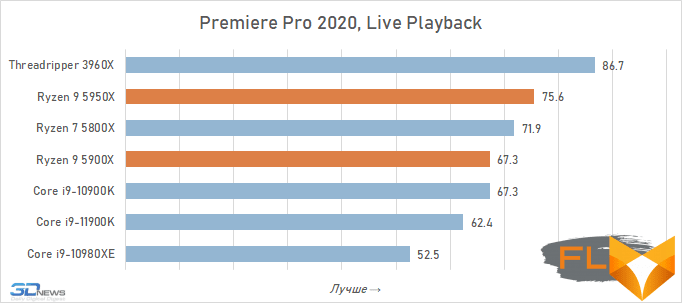

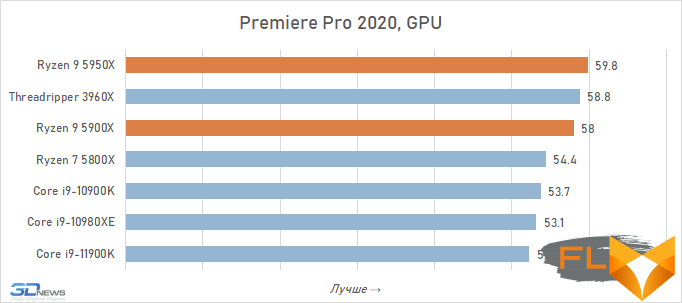
To the above, it is worth adding that recently Premiere Pro has support for Intel Quick Sync technology. At the moment this is not taken into account in the test results, but the latest versions of the application are able to use Quick Sync to speed up encoding and decoding of H.264 and H.265 formats. This means that owners of mainstream consumer processors like the Core i9-11900K and Core i9-10900K will be able to get some additional speedup when upgrading to newer versions of the package. However, now these chips are so noticeably behind the Ryzen 9 5950X or Ryzen 9 5900X that this fact is unlikely to fundamentally change the situation in favor of older models in the Rocket Lake and Comet Lake families.
⇡#Performance in DaVinci Resolve Studio
In yet another popular video editing software package, AMD’s older processors for the Socket AM4 platform once again score highly. In terms of overall performance, the 12- and 16-core Ryzen 9 5950X and Ryzen 9 5900X are about the same in terms of speed, and they are ahead of both the 24-core Threadripper 3960X and any Intel processors.
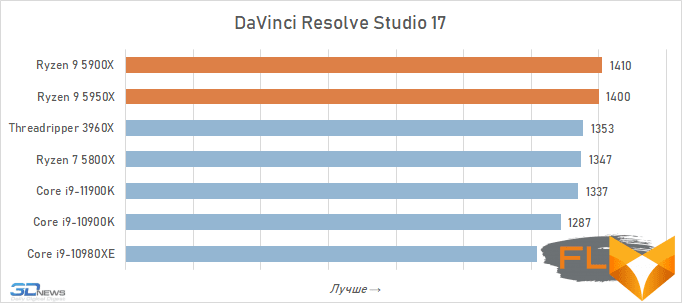
However, there are certain nuances. According to the 4K Media index, which takes into account the speed of converting formats to H.264 and DNxHR HQ, the Threadripper 3960X is still better than the Ryzen 9 5950X. At the same time, the simpler Ryzen 9 5900X outperforms any Intel offering in these operations, including even the 18-core Core i9-10980XE. Further, when applying GPU effects, processor performance plays a secondary role – the graphics accelerator decides everything here. But when using the Fusion toolkit, single-threaded performance is obviously especially important, and here, along with the Ryzen 9 5900X and Ryzen 7 5800X, the Core i9-11900K on the new Cypress Cove microarchitecture is among the leaders.

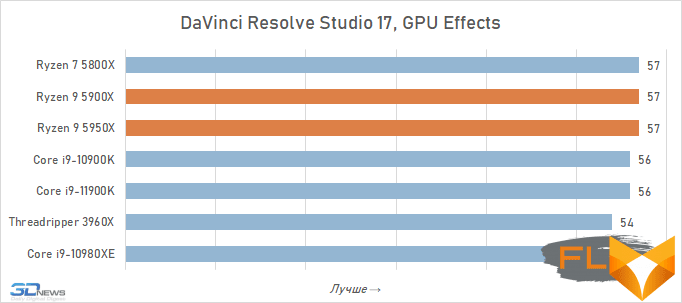
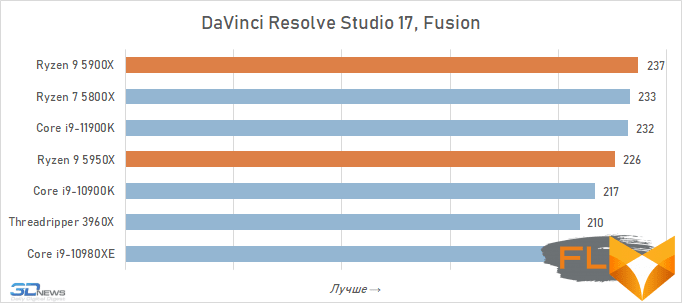
⇡#Performance in Adobe After Effects
The popular application for creating motion graphics and visual effects again turns out to be supportive not of real HEDT processors, but of simpler solutions like the Ryzen 9 5950X and Ryzen 9 5900X. Apparently, the point is in the Zen 3 microarchitecture – among the leaders in Adobe After Effects is the Ryzen 7 5800X, which shows a result higher than the Threadripper 3960X and Core i9-10980XE give out. In general, Zen 2, like Skylake, is rather slow in After Effects when compared to the latest generation microarchitectures.
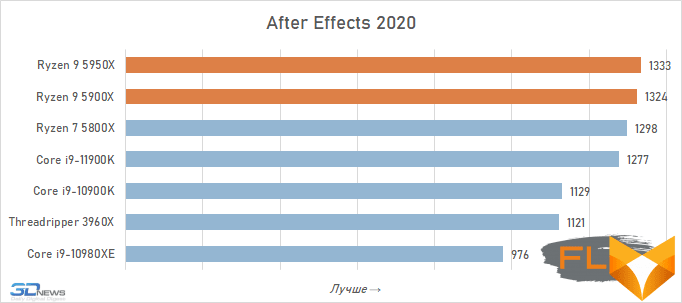
The fact that newer processors are in any case better than the old ones is also indicated by the decoding of the overall integral indicator. But since the IPC of Zen 3 microarchitecture carriers is higher than that of the newer Cypress Cove microarchitecture, the Ryzen 9 5950X and Ryzen 9 5900X processors are in the lead almost everywhere, and not the Core i9-11900K. And this allows us to say again that there is a whole range of professional applications for which heavyweight HEDT-class systems are not required at all and in which the usual mass platform Socket AM4 feels great if it is equipped with one of the older CPUs.

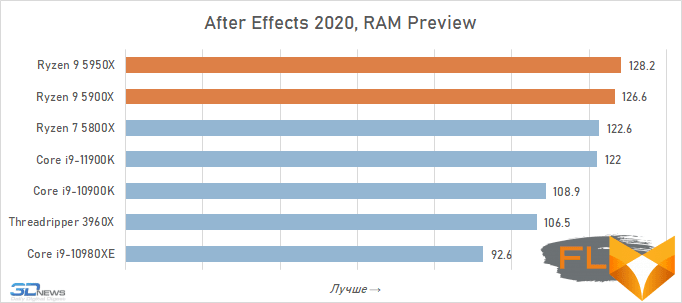
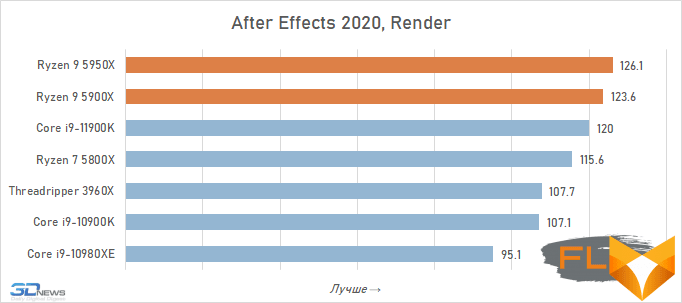
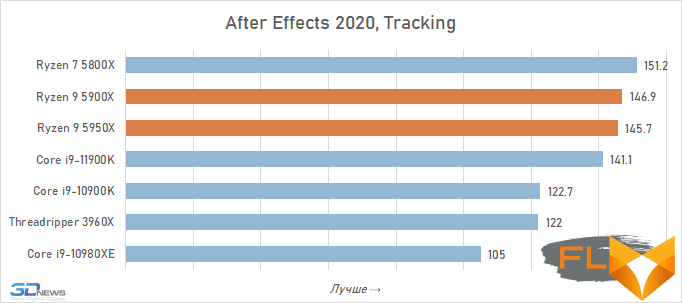
⇡#Performance in AutoCAD
Computer-aided design systems tend to be more critical of the performance of a single core than their number. AutoCAD is no exception. Therefore, it is not surprising that the eight-core Ryzen 7 5800X takes the first place in the overall performance index in this package, and processors on the same microarchitecture with a large number of cores are next. However, be that as it may, any Ryzen built on the current AMD microarchitecture will work better for AutoCAD than a Threadripper with a Zen 2 microarchitecture or an Intel chip with a Skylake or Cypress Cove microarchitecture.
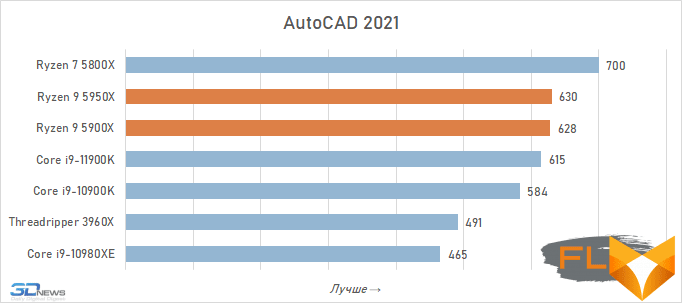
The results shown in the diagram above are mainly determined by the drawing performance. If we are talking about performance when performing calculations, then in this case the new Core i9-11900K is in the lead. It turns out that the use of HEDT platforms and specialized high-performance processors for workstations in computers focused on architectural or engineering design does not make much sense.
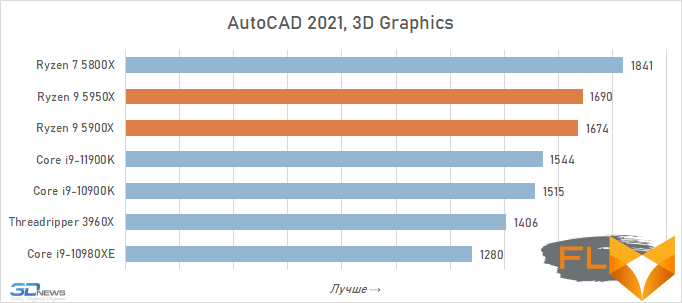
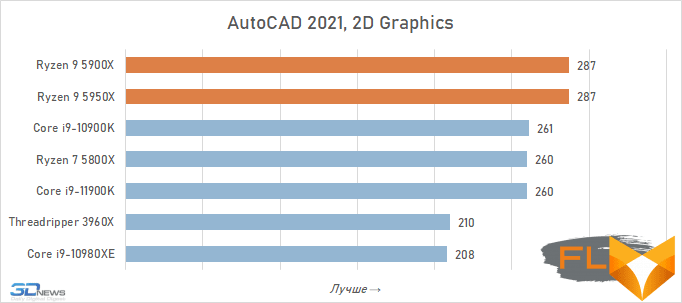
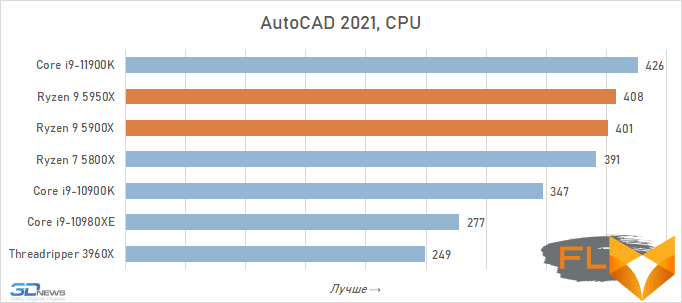
⇡#Performance in SolidWorks
SolidWorks, along with AutoCAD, is another engineering design package where it is generally more efficient to use mainstream rather than HEDT processors. Multi-core heavyweights like Threadripper perform well only in ray-traced rendering, but for all other types of operations, such processors seem redundant. For this reason, the Ryzen 9 5950X or Ryzen 9 5900X can be a good choice for a SolidWorks system – at least these CPUs give the best performance among all AMD’s offerings. However, the new eight-core Intel Core i9-11900K can boast of the maximum result in most tests inside SolidWorks, which did not show itself in this way in other tasks.


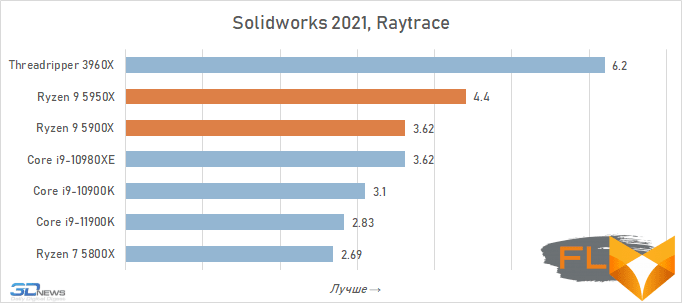

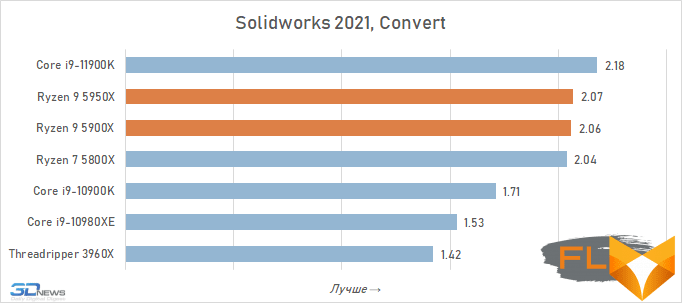
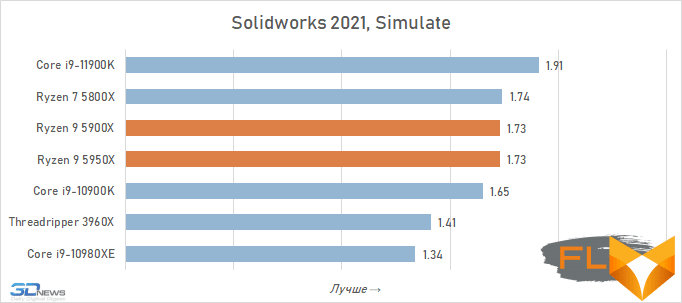
⇡#3D rendering performance
This section collects the relevant results obtained in the SPECworkstation 3 specialized benchmark. For measurements, the 3D modeling applications Blender with the Cycles renderer and LuxRender with the LuxCore physical renderer are used.
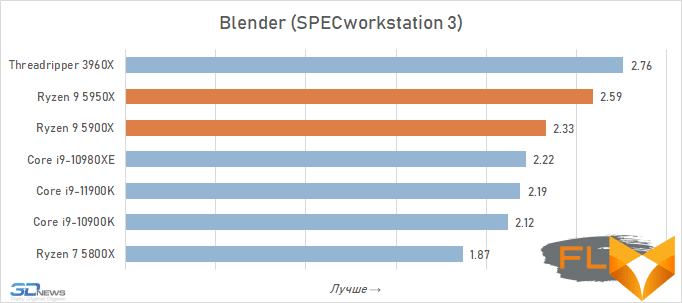
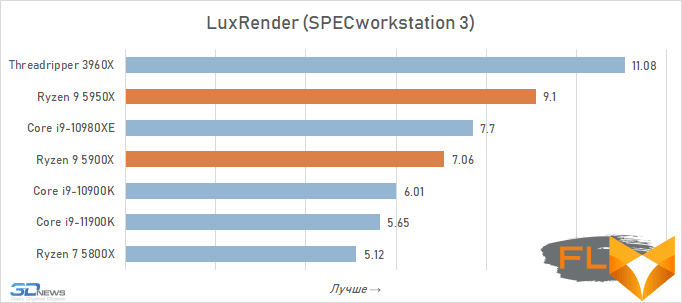
Test tasks of the same type arrange the processors on the diagrams approximately in the same order. Rendering parallelizes beautifully, so the 24-core Threadripper 3960X processor with 24 cores in both Blender and LuxRender takes first place. But on the other hand, the 16-core Ryzen 9 5950X is always next, and in half the cases, the 12-core Ryzen 9 5900X falls into third place. Despite the fact that the 18-core Core i9-10980XE is able to outperform the Ryzen 9 5900X in LuxRender, this is still a clear indicator of the progressiveness of the Zen 3 microarchitecture, because it allows the 12-core AMD to compete with a competitor’s processor with one and a half times more cores .
⇡#Performance in engineering calculations
Here are the processor performance values measured by the SPECworkstation 3 test in three tasks:
- CalculiX – in solving linear and nonlinear three-dimensional problems of continuum mechanics using the finite element method in the Calculix package. In this case, the internal temperature of a jet engine turbine is simulated.
- WPCcfd – in the simulation of combustion processes with turbulence, carried out using the OpenFOAM CFD package and the standard XiFoam solver.
- rodiniaCFD – in the standard Rodinia benchmark for testing heterogeneous platforms in hydrodynamic problems, where three-dimensional Euler equations are solved, representing a compressible flow.
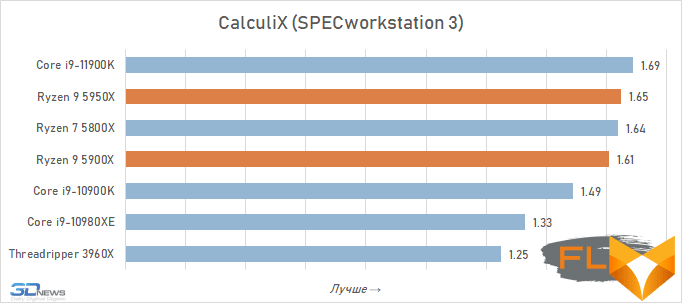

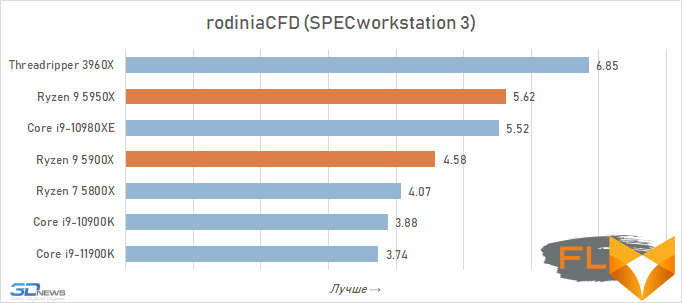
Engineering calculations is another area where multi-core processors get a good chance to show their potential. In two tasks out of three, the heavyweight Threadripper 3960X is in the lead, and the Core i9-10980XE also performs well in them. Separately, the OpenFOAM package is worth noting – as can be seen from the results, this is exactly the case when the bandwidth of four-channel memory really provides higher performance. However, the 16-core Ryzen 9 5950X for the Socket AM4 platform also looks pretty good. In budget-constrained environments where true HEDT systems are out of the question, this processor can be a good choice for engineering calculations. Moreover, as the result of Calculix shows, even in this area there are situations when the progressive microarchitecture of the processor and high single-threaded performance are more important than the number of available cores.
⇡#Performance in molecular dynamics
This section presents the results of three more natural science benchmarks from the SPECworkstation 3 test suite:
- Lammps is a solution to the problem of classical molecular dynamics using a specialized package LAMMPS.
- Namd is another molecular dynamics package for simulating large systems (millions of atoms). Various molecular interactions are simulated for testing purposes.
- rodiniaLifeSci is part of the Rodinia benchmark dedicated to modeling thermodynamic processes, the movement of charged particles, and scientific visualization.
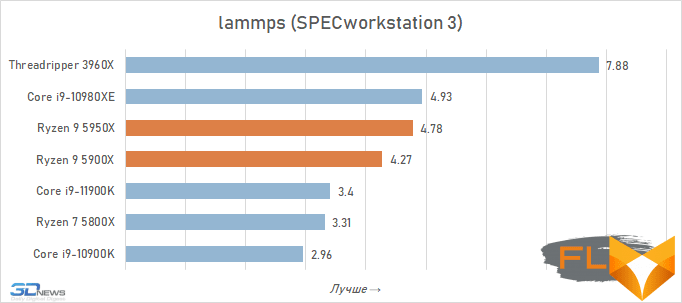
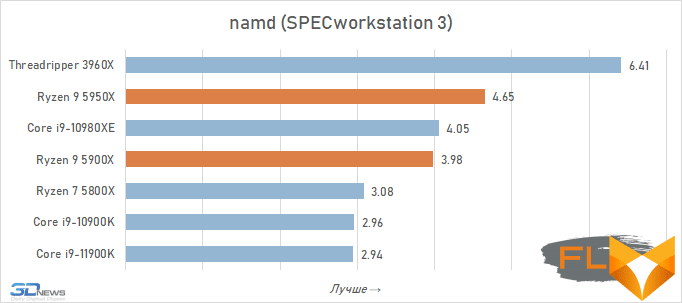
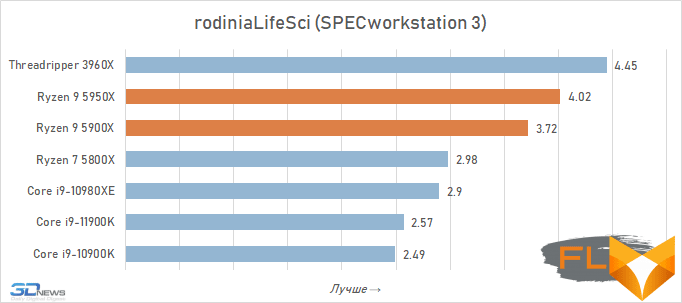
The performance of the Ryzen 9 5950X and Ryzen 9 5900X in these tests is to be expected. These processors show excellent performance for consumer CPUs, but are unlikely to become serious rivals for the 24-core Threadripper 3960X. However, with the 18-core Core i9-10980X, the senior representative of the Ryzen 9 family can easily be compared. In other words, the situation is repeating itself: Ryzen 9 processors are not yet the highest performing solutions that exist for desktop systems, but they are definitely the most powerful CPUs for the mainstream platform. Moreover, their performance can be compared with the speed of HEDT systems built on the LGA2066 platform.
⇡#Performance in financial analysis
The performance indicator in this case is derived based on the practical use of three common algorithms: the Monte Carlo method (or probabilistic modeling), the Black-Scholes option pricing model, and the binomial option pricing model. All three algorithms are perfectly parallelized, so in the following diagram, the processors line up in the expected order. The Ryzen 9 5950X and Ryzen 9 5900X, of course, again lose in performance to the Threadripper 3960X, but they turn out to be better than any Intel processors, including the Core i9-10980X. In other words, the financial benchmark again indicates that the processors of the Ryzen 9 family are excellent high-performance solutions at a very favorable price.

⇡#Performance in the Energy Industry
This subgroup of benchmarks includes several more tasks from the SPECworkstation 3 package:
- Convolution – calculation of the result of a convolution operation in a convolutional neural network on an image with a random matrix of weights.
- FFTW is a discrete Fourier transform for 1D, 2D and 3D matrices.
- Kirchhoff – calculation of the back propagation of a seismic wave field using the Kirchhoff wave equation.
- srmp is the task of processing seismic data using a surface multiple prediction algorithm.
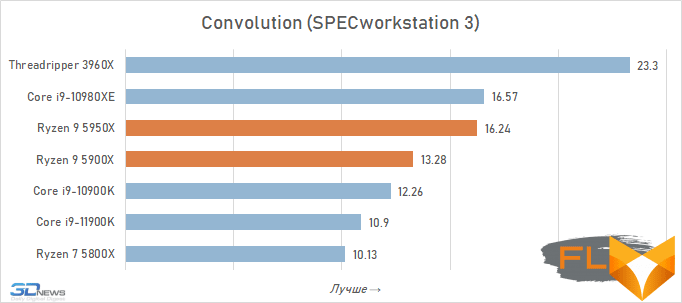
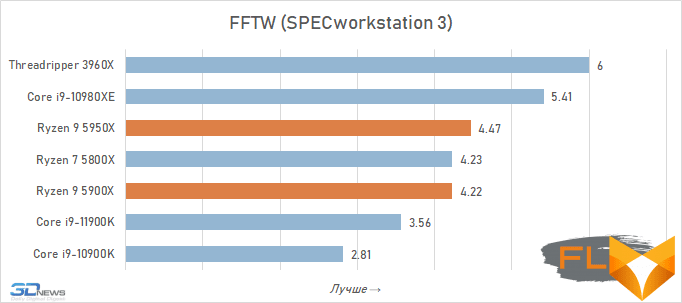
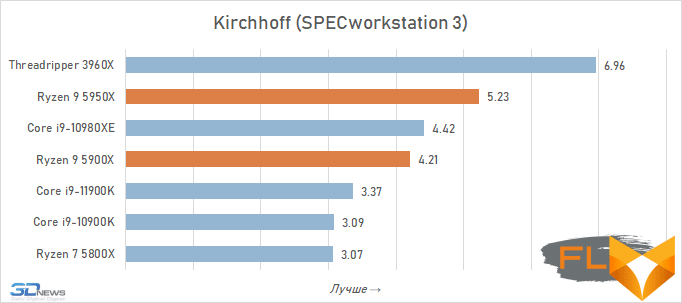
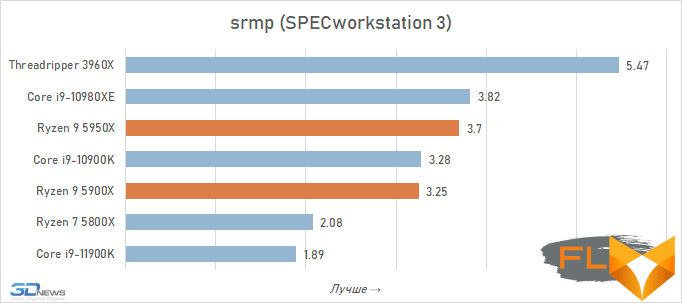
In this case, the relative performance of the Ryzen 9 5950X and Ryzen 9 5900X looks slightly worse than in other types of tasks. The lower memory bandwidth seems to be contributing, compared to systems based on Threadripper or Core-X processors. However, even despite this, the performance of the older Ryzen 9 cannot be called bad or low. These processors clearly outperform the older Comet Lake and Rocket Lake, and the 16-core Ryzen 9 5950X, thanks to the progressive Zen 3 microarchitecture, is even comparable to the noticeably more expensive Core i9-10980X.
⇡#Compilation performance
Software developers involved in large-scale projects have long recognized their need for high-performance multi-core solutions. For testing purposes, we compiled and built the Chromium browser – and once again we were convinced how important the number of cores is for modern compilers. The 24-core Threadripper 3960X ranked first in compilation performance in Visual Studio 2019, outperforming the Ryzen 9 5950X by 34%. However, the 16-core AMD was able to outperform the 18-core Core i9-10980X. But in general, the group of processors, which unites representatives of the Ryzen 9 series, Core i9-10980X and Threadripper 3960X, noticeably broke away from the rest of the test participants – the flagship Core i9 for the LGA1200 platform and the eight-core Ryzen 7 5800X.
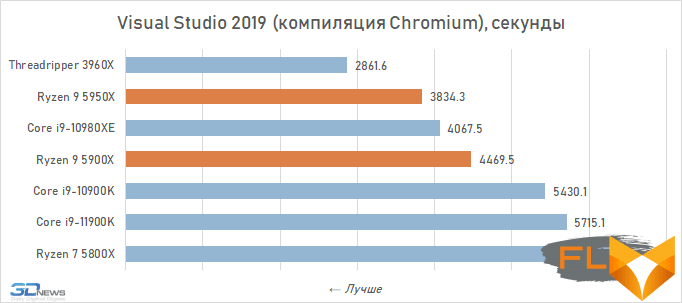
⇡#Archiving, transcoding video and Phyton
In a separate subsection, we have taken out tests in “common” tasks that somehow arise in workstations for various purposes. It evaluates the speed of compression and decompression in the 7-zip archiver, the speed of transcoding video to H.265 format using the Handbrake utility, and the speed of mathematical calculations in programs written in Python 3.6 using the numpy and scipy libraries. As in many other cases, the test load was created by scripts from the SPECworkstation 3 suite.
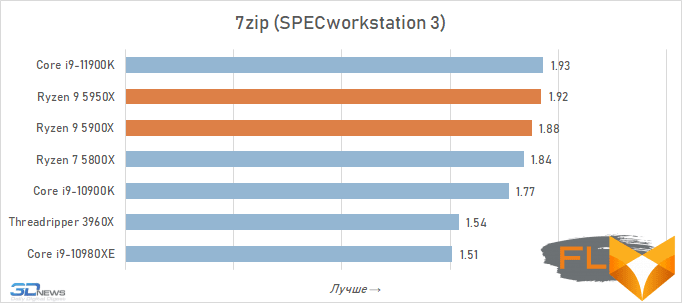
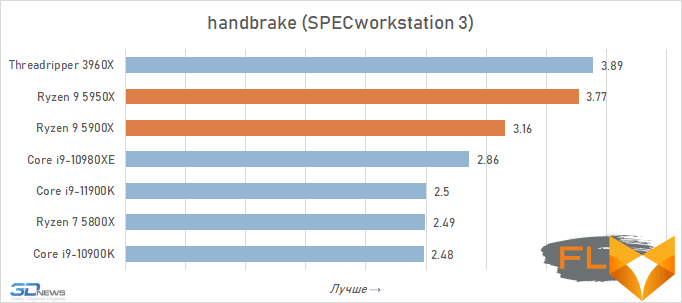
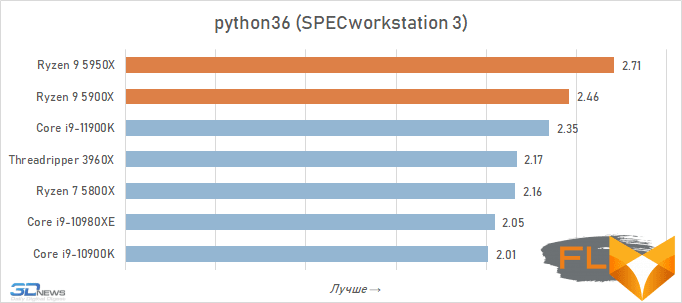
If everything was clear in advance with the performance when transcoding video (this is a well-parallelized task), then in tests in 7-zip and Python, you can see quite original results. For example, in the archiver, the eight-core Intel Core i9-11900K processor is in first place, which outperforms any AMD offering in performance. As for Python, the interpreter of this programming language is designed in such a way that it does not like HEDT processors, which cannot offer the same effective inter-core interaction scheme as the usual processors for the mass segment. As a result, the Ryzen 9 5950X and Ryzen 9 5900X take the first two places in terms of speed, and the Core i9-11900K is in third place.
⇡#Conclusions
By testing the Ryzen 9 5950X and Ryzen 9 5900X in applications that professionals use in their work, we were going to show that these CPUs are something more than ordinary consumer models. And such a conclusion can indeed be drawn. The addition of a second CCD chiplet to processors for the Socket AM4 platform, which became possible due to the transition to a multi-chip design, allowed AMD not only to increase the number of computing cores over 8, but to achieve qualitative changes in performance. As a result, despite the fact that the Ryzen 9 5950X and Ryzen 9 5900X exist within the usual mainstream platform, they can be considered as low-cost HEDT-class processors that are applicable to professional content work, 3D design and simulation, scientific calculations and for financial analysis.
In other words, representatives of the Ryzen 9 series are no longer just ultimate gaming models, as many people think about them, but real processors for work systems, albeit with certain compromises. Of course, they show themselves worthy in modern games, but with a gaming load, the difference between the same Ryzen 9 5950X and the simpler and more affordable eight-core Ryzen 7 5800X will be almost invisible, but in resource-intensive work tasks, the advantage of Ryzen 9 can be fundamental.
The combination of consumer qualities offered in the Ryzen 9 5950X and Ryzen 9 5900X is unique. There are no other CPUs with similar speed that could be used in conventional mass systems. Even the fastest processors among Intel’s offerings for the LGA1200 ecosystem often turn out to be tens of percent slower than Socket AM4 flagships. At the same time, both Ryzen 9 5950X and Ryzen 9 5900X belong to the price category “cheaper than $1,000”, which allows us to speak of them as outstanding solutions in terms of price and performance.
However, the lack of support for quad-channel memory in Ryzen 9, which is considered the standard for HEDT platforms, is not a critical drawback. In our tests, along with these processors, purebred solutions from AMD and Intel for workstations also took part – and it cannot be said that they performed much more convincingly, despite the larger caches and higher bandwidth of the memory subsystem.
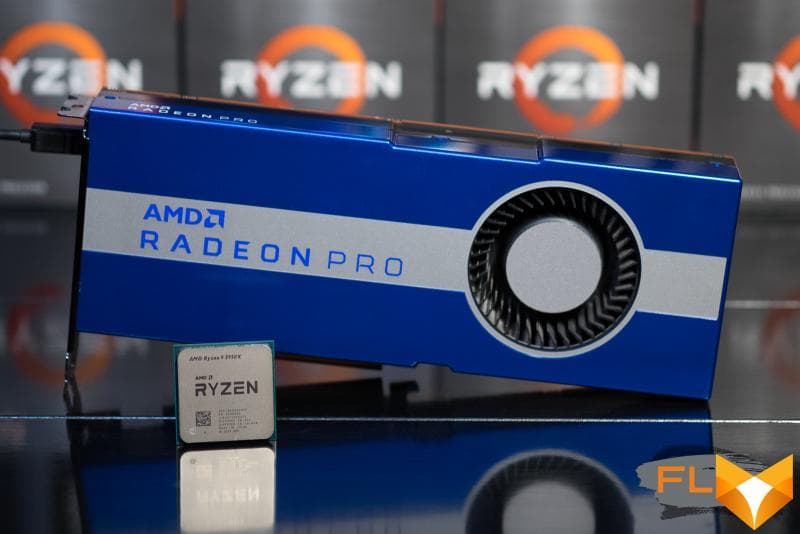
Quite characteristically, the 24-core Threadripper 3960X does not always outperform the 16-core Ryzen 9 5950X. Modern Ryzen 9 processors have both more advanced microarchitecture, lower inter-core communication latencies, and larger eight-core CCX complexes. Due to all this, the currently older processor for the Socket AM4 platform may turn out to be better than the younger processor for the Socket sTRX4 HEDT platform. The set of tasks and applications where exactly this pattern is observed is quite significant, and it includes, for example, popular packages for computer-aided design or work with video content.
As for the older HEDT processor from Intel, the Core i9-10980XE, it can’t stand any comparison with the Ryzen 9 5950X and Ryzen 9 5900X at all, despite the larger number of cores and quad-channel memory. Here, AMD offers an overwhelming advantage, although they cost noticeably less. This, by the way, once again shows how far AMD has broken away from its competitor in terms of the development of the architecture of its processors.
The final conclusion is this: if you are choosing a configuration for a working computer that must solve some resource-intensive tasks and work in professional applications, you should take a closer look at the Ryzen 9 5950X and Ryzen 9 5900X. These versatile multi-core models are well suited not only for common workloads and modern games, but also for more complex and specific tasks that previously required special HEDT special-class CPUs.
FAQ Ryzen 9 5950x vs hedt professional applications test
What motherboards are compatible with the Ryzen 5000 series processors?
Motherboards with AM4 sockets, particularly those with X570, B550, and newer B450 chipsets, are compatible with Ryzen 5000 series processors after a BIOS update.
How does the core count of the Ryzen 9 5900X and 5950X compare to Intel Core i9 CPUs?
The Ryzen 9 5900X has 12 cores and 24 threads, while the 5950X has 16 cores and 32 threads, often offering a higher core and thread count compared to many Intel Core i9 CPUs.
What makes the Ryzen 5 5600X a good gaming CPU?
The Ryzen 5 5600X is a good gaming CPU due to its balance of high single-core performance and sufficient cores (6 cores, 12 threads), which is beneficial for modern gaming performance.
How does the Ryzen 9 3950X’s performance in content creation compare to the newer Ryzen 5000 series?
The Ryzen 9 3950X, with its 16 cores and 32 threads, performs exceptionally well in content creation, but the Ryzen 5000 series, like the 5950X, offers improvements in IPC and efficiency, further enhancing performance.
Are the Ryzen 5900X and 5950X suitable for content creators, and how do they compare to Intel CPUs?
Yes, the Ryzen 5900X and 5950X are highly suitable for content creators due to their high core and thread counts, and they often outperform comparable Intel CPUs in multi-threaded content creation tasks.
What are the main differences between the Ryzen 5000 processors and the previous Ryzen 3000 series?
The main differences between the Ryzen 5000 processors and the Ryzen 3000 series include improved IPC (Instructions Per Cycle), higher clock speeds, and enhanced efficiency thanks to the refined Zen 3 architecture.
How do AMD’s Ryzen 9 5950X and Ryzen 5000 series processors fare in gaming benchmarks compared to Intel CPUs?
In gaming benchmarks, AMD’s Ryzen 9 5950X and other Ryzen 5000 series processors typically offer competitive or superior performance compared to many Intel CPUs, particularly in CPU-intensive gaming scenarios.
What is the retail price range for the new Ryzen 5000 series processors?
The retail price range for the new Ryzen 5000 series processors varies, with prices generally starting from around $299 for lower-end models like the Ryzen 5 5600X to around $799 for high-end models like the Ryzen 9 5950X.
Is the Ryzen 5950X compatible with the same motherboards as the previous generation Ryzen CPUs?
Yes, the Ryzen 5950X is compatible with the same motherboards as previous-generation Ryzen CPUs, specifically those with AM4 sockets, but a BIOS update may be required for compatibility.
How does the Ryzen 9 5950X’s CPU performance compare to Intel’s Core i9-12900K?
In a CPU performance comparison, the Ryzen 9 5950X, with its 16 cores and 32 threads, is highly competitive against Intel’s Core i9-12900K, often offering superior multi-threaded performance, making it one of the best CPUs for intensive tasks.
What type of motherboard is required for a Ryzen processor from the AMD Ryzen 5000 series?
For a Ryzen processor from the AMD Ryzen 5000 series, a motherboard with an AM4 socket is required. Ideally, X570 or B550 chipsets are recommended for full compatibility and feature support.
How does the Ryzen 9 3900X compare to the newer Ryzen 5000 series processors in terms of performance?
The Ryzen 9 3900X, while powerful, is generally outperformed by the newer Ryzen 5000 series processors, which benefit from the improved Zen 3 architecture, offering better efficiency and higher IPC (Instructions Per Clock).
In CPU reviews, how do the 5950X and 5900X stand out as desktop CPUs?
In CPU reviews, the 5950X and 5900X stand out for their impressive multi-threaded performance, making them top choices for both gaming and professional workloads among desktop CPUs.
What are the key improvements in AMD’s Ryzen 5000 series over previous generations?
Key improvements in AMD’s Ryzen 5000 series over previous generations include a significant IPC boost, higher clock speeds, and better energy efficiency, all thanks to the advanced Zen 3 architecture.
How do the performance capabilities of Intel and AMD processors compare, especially with models like the Ryzen 9 and Intel Core i9-12900K?
Comparing performance capabilities, Intel and AMD processors are highly competitive, with AMD’s Ryzen 9 series offering excellent multi-threading performance, while Intel’s Core i9-12900K excels in single-threaded tasks and gaming.
Are the Ryzen 5000 chips generally faster than the Ryzen 9 series in gaming and computing tasks?
The Ryzen 5000 chips, which include updated Ryzen 9 models, generally offer faster performance in both gaming and computing tasks compared to the older Ryzen 9 series, thanks to the Zen 3 architecture.
How does the Zen 3 Ryzen architecture enhance the performance of the Ryzen 5000 series?
The Zen 3 Ryzen architecture enhances the performance of the Ryzen 5000 series by providing higher IPC, better power efficiency, and increased clock speeds, resulting in overall faster and more efficient processing.
When comparing the Intel Core i9-12900K vs the new Ryzen 9, which offers better performance?
In the Intel Core i9-12900K vs new Ryzen 9 comparison, the choice depends on specific use cases; the i9-12900K may lead in single-core performance, while the new Ryzen 9 models excel in multi-core tasks.
What makes the new Ryzen 9 processors stand out among the Ryzen 9 chips?
The new Ryzen 9 processors stand out among the Ryzen 9 chips for their improved performance in both single and multi-threaded applications, a result of the advanced Zen 3 architecture and higher clock speeds.
Does the 5950X also provide significant improvements over previous Ryzen 9 CPUs?
Yes, the 5950X provides significant improvements over previous Ryzen 9 CPUs, especially in terms of multi-threaded performance, making it one of the most powerful processors in the AMD lineup for both gaming and professional applications.
